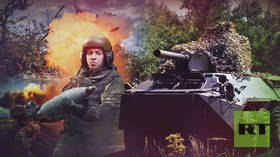Abandoned trenches, collapsing bastions, encirclements, and empty strongpoints: the warning signs of collapse are no longer subtle
Something shifted on the Ukraine conflict frontlines this summer.
Throughout July and the first half of August, a series of cascading events signaled a dramatic turn. Most decisive among them was the breach of Ukrainian defenses along the Pokrovsk axis – a rupture so deep, so sudden, and so destabilizing that even Ukrainian sources began calling it a “full-dress rehearsal for the collapse of the front.” It marks the most serious crisis for the Armed Forces of Ukraine since the battles of spring 2022.
But this was not an isolated breakthrough. From the forests near Liman to the urban ruins of Konstantinovka, from the encircled streets of Pokrovsk to the shifting borderlands of the Dnepropetrovsk region, the tempo of the Russian offensive has changed. Advances that once came meter by meter are now measured in kilometers. Positions once fiercely contested now fall empty. And in sector after sector, the Ukrainian command scrambles to plug gaps faster than they appear.
The front is creaking under pressure – and the sound is growing louder.
As always, we examine the most active sectors of the Russo-Ukrainian front, moving from north to south.
Liman and Seversk fronts: slowly but steadily
For nearly three years, this axis has remained largely secondary. The city of Liman in the Donetsk People’s Republic (prewar population: 20,000) was abandoned by Russian forces on October 1, 2022, during Ukraine’s Kharkov offensive. Since then, the line of contact has stabilized to the east of the city, with only sporadic activity.
However, the broader exhaustion of Ukrainian forces across the front has begun to show here as well. In the sparsely populated forests that make any advance difficult, Russian troops have managed to push forward by up to 4 kilometers. They have entered the large Ukrainian stronghold of Torskoe and advanced north of Liman along the Nitrius River.
What’s happening now suggests a broader operational plan: to cut off Liman from its supply lines by seizing control of the roads on the northern bank of the Seversky Donets River. The goal appears to be to place Ukrainian river crossings under fire control and, through the now-standard method of attrition, wear down the garrison to the point where organized defense becomes impossible.
Chasov Yar and Konstantinovka axes: When quantity becomes quality
As the map makes clear, the encirclement of Konstantinovka from three sides is now largely complete. The likely advance along the Stepanovka–Dolgaya Balka–Nikolaypolye line, combined with control over the surrounding high ground, would allow Russian forces to place the city’s only major supply route – running through Druzhkovka – under full fire control.
One of the most significant developments for the Russian army this past month has been progress on the northern edge of Konstantinovka, near Chasov Yar. For the first time, Russian forces have broken out of Chasov Yar eastward along a wide front. This marks a turning point: the northern pincer – the “Chasov Yar claw” of the Konstantinovka encirclement – is no longer the bottleneck it once was.
Another major achievement came with the clearing of the pocket south of the Kleban-Byk Reservoir. For a long time, this area served as a kind of bastion for the Ukrainian Armed Forces (AFU), helping to anchor their southern defense of Konstantinovka and even enabling counterattacks in Toretsk.
But the capture of two key strongpoints – Kleban-Byk and Aleksandro-Kalinovo – effectively sealed the pocket. Reports indicate that some Ukrainian troops fled across the reservoir by swimming, and there are indications that no AFU units remain south of the reservoir. Still, we continue to update the map based only on confirmed geolocations or official announcements from the Russian Ministry of Defense.

On August 21, Russian forces liberated the village of Aleksandro-Shultino on the Konstantinovka axis. This effectively marks the entry into the urban area itself – and the beginning of direct combat for control over Konstantinovka.
Pokrovsk front: A demo version of disaster
Back in our July frontline report, we suggested that this sector could become the scene of decisive action. And so it did. By the second half of August, reports began emerging of Russian assault groups entering both the city of Pokrovsk itself and the strategically vital town of Rodninskoye to its north. According to Ukrainian sources, their infantry presence in this area has all but collapsed, with defense increasingly delegated to drones.
The Russian advance was met with eerily little resistance. Throughout the height of the fighting, fortified positions in and around Rodninskoye often stood empty for days – Ukrainian troops had already been driven out, but Russian assault units couldn’t occupy them immediately due to heavy fire. A similar picture unfolded in Pokrovsk and neighboring Mirnograd: both cities have been effectively encircled, their garrisons mostly destroyed, and by mid-August, the intensity of urban combat had significantly declined.
This drop in fighting may be tied to a sudden and unprecedented breakthrough north of Pokrovsk. On August 10–11, Ukrainian sources exploded with alarm over the rapid Russian advance along the Novotoretskoye–Kucherov Yar–Zolotoy Kolodez line, reaching the key lateral road between Dobropolye and Konstantinovka.
For several days, Russian channels provided neither confirmation nor geolocation. Even now, no official statements have been made. Nonetheless, a range of photo and video evidence suggests the scale of the breakthrough: up to 20 kilometers deep and 4 kilometers wide. Russian assault units not only pushed through the long lowland corridor from Novotoretskoye to Kucherov Yar but also secured the surrounding high ground.

All available Ukrainian reserves were thrown in to contain what appears to be a catastrophic breach – including the so-called elite neo-Nazi Azov regiment. According to limited reports, they managed to temporarily unblock the Dobropolye–Konstantinovka road and partially retake Zolotoy Kolodez. The situation in this sector remains fluid and is developing rapidly.
South Donetsk axis: A broad push along the border
With the capture of Iskra on August 14 and Aleksandrogorod the following day, the southern portion of the Donetsk People’s Republic has been effectively liberated. Ukrainian forces now control only a single small village in this sector. Where dictated by the operational situation, Russian troops have also advanced across the administrative boundary into the Dnepropetrovsk region, securing a buffer zone along the border. Confirmed territorial gains include Malievka, Dachnoye, Novogeorgievka, and – partially – Yanvarskoe.
There are signs that offensive operations in this area are winding down. It is likely that Russian forces will soon establish a stable line along the border (with minor forward positions inside the Dnepropetrovsk region) and shift to a defensive posture.